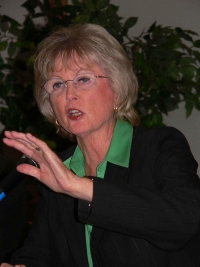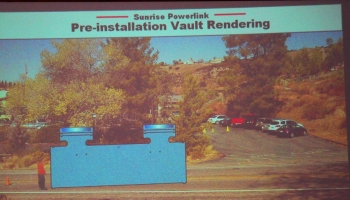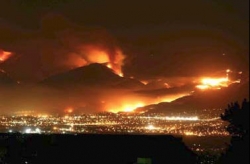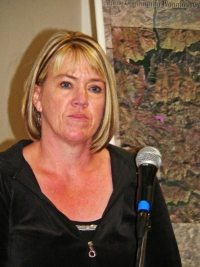|
By Diana Barreto and Miriam Raftery
"We have done everything we can to make sure everyone here, and everyone else who is not here, gets to know exactly what is being ramrodded down our throats." -- Milt Cyphert, co-founder, East County Community Action Coalition |
January 17, 2010 (Alpine) San Diego Gas and Electric’s current proposal for Sunrise Powerlink, including undergrounding high-voltage power lines along Alpine Boulevard, was not well received by 400-plus people at a meeting on January 14th. County Supervisor Dianne Jacob convened the meeting to show the community information left out of the latest report submitted by SDG&E to the Public Utilities Commission (PUC) in Sacramento.
 Jacob said her number one goal is to stop the project. Ultimately she believes the courts will decide the fate of Powerlink; multiple lawsuits seek to halt the project by challenging approvals by the PUC and by the federal Bureau of Land Management. In addition, the U.S. Forest Service has not yet granted approval for Powerlink construction through the Cleveland National Forest. If the project does get built, Jacob said she would fight to do as much as possible to minimize the negative impact this project would have on the community.
Jacob said her number one goal is to stop the project. Ultimately she believes the courts will decide the fate of Powerlink; multiple lawsuits seek to halt the project by challenging approvals by the PUC and by the federal Bureau of Land Management. In addition, the U.S. Forest Service has not yet granted approval for Powerlink construction through the Cleveland National Forest. If the project does get built, Jacob said she would fight to do as much as possible to minimize the negative impact this project would have on the community.
At the start of the meeting, just two people raised hands indicating they were for the project, 25 people remained undecided, and the vast majority were against it. That was before County staff presented evidence that construction would use massive amounts of water, create serious traffic delays and disruption to local businesses for up to two years, among other impacts. (SDG&E was slated to submit new documents to the PUC on Friday; ECM is requesting a copy and will post it when obtained.)
 “This project will require millions of gallons of water. Most will come from groundwater dependent areas,” said Eric Gibson from the Department of Planning and Land Use.
“This project will require millions of gallons of water. Most will come from groundwater dependent areas,” said Eric Gibson from the Department of Planning and Land Use.
 Many community members stood up to voice their concerns about impacts of the project. Responding on behalf of SDG&E were Linda McDonald and Jose Lopez, an expert on undergrounding.
Many community members stood up to voice their concerns about impacts of the project. Responding on behalf of SDG&E were Linda McDonald and Jose Lopez, an expert on undergrounding.
A presentation by County staff cited information pertinent to the decision-making process in Sacramento that was left out of the report given to the PUC by SDG&E. Major regional impacts presented include fire safety, groundwater resources, biological resources, multiple species conservation plan (MSCP) lands, and additional access in the backcountry that could introduce unauthorized or illegal activities.

The presentation also illustrated dimensions of trenches for the underground power lines and also the length and location of the entire project. Along Alpine Boulevard, 40 subterranean vaults would be built, each measures 26 x 12 by 12 feet. (illustration, left)
Attendees seemed concerned about all of these issues as well as the effect the construction on Alpine Boulevard would have on businesses in the area.
Linda McDonald of SDG&E replied that if the roads were closed, "golf carts could be used" as alternatives to ferry customers and allow businesses to remain open. The audience responded with derisive laughter.
“This could put me out of business,” Michelle Little, owner of the Vines restaurant, told East County Magazine after the meeting.
Other major concerns voiced by the public were health and safety issues.
Fire safety issues were brought up by the co-founder of the East County Community Action Coalition, Milt Cyphert, and other members of the community.
 “I don’t know of any airplanes or helicopters who are going to go into any blind patch of smoke when they don’t know where the lines are,” said Cyphert, who lost his home in the Cedar Fire (photo, right). Firefighters would be unable to fight fires without air support, meaning if a backcountry area near the lines catches fire,”They’re just going to have to let it burn—until it gets to a population center where there are homes,” he said, “and then how are you going to stop a 25 mile fire line or longer, because you let it burn out of control?”
“I don’t know of any airplanes or helicopters who are going to go into any blind patch of smoke when they don’t know where the lines are,” said Cyphert, who lost his home in the Cedar Fire (photo, right). Firefighters would be unable to fight fires without air support, meaning if a backcountry area near the lines catches fire,”They’re just going to have to let it burn—until it gets to a population center where there are homes,” he said, “and then how are you going to stop a 25 mile fire line or longer, because you let it burn out of control?”
View videos of Milt Cyphert’s testimony, which drew a rousing ovation from the crowd: Part 1, Part 2 (above), Part 3 .
Cyphert, a heating and air conditioning contractor, said he has worked on high voltage equipment and seen what happens when smaller lines fail, creating a “molten arc” of steel, copper and aluminium. “If a 12 KV line can blow up and blow a manhole cover a block away and go through a car windshield, what’s going to happen to a 230 kv line when its wires start to get corroded and electrical connections start to heat up,” he asked, “and eventually it has a boom and it’s right there beside the school?...Do we let kids play in the park, in the recess area right there or not?”
 A concerned mother, Michelle Steinbuck of Alpine, voiced her worries about the construction happening near the elementary school and the electromagnetic fields that would result from the underground power lines. She was also worried about her home devaluing due to these resulting power lines. “Who is going to move to Alpine and put their kids in a school 40 or 50 feet from a high-voltage line?” she asked.
A concerned mother, Michelle Steinbuck of Alpine, voiced her worries about the construction happening near the elementary school and the electromagnetic fields that would result from the underground power lines. She was also worried about her home devaluing due to these resulting power lines. “Who is going to move to Alpine and put their kids in a school 40 or 50 feet from a high-voltage line?” she asked.
In addition, she voiced concern over safe evacuation in the event of a new fire. “We waited almost an hour with kids in my car,” she recalled, noting that Alpine Blvd. was clogged during a prior wildfire. “If we shut lanes down, how are we able to leave safely in case of a fire, and how are we to get gas?”
Laura McDonald of SDG&E insisted that covers could be put over open vaults quickly in the event of an emergency requiring evacuation.
Two other community members were also concerned about the electromagnetic fields that could have been the source for their family members having cancer. A man from Boulevard said that after Southwest Powerlink was run through his property, “My wife would have these dizzy spells and just pass out.” She was diagnosed with disruption of red blood cells in her bone marrow and has been on chemotherapy for 18 years, he said, adding that a hematologist said exposure to electromagnetic frequencies (EMFs) may be the cause of her illness.
Another woman noted research linking EMFs to childhood leukemia. “They are exposing each and every one of us to the possibilities of changing our cells,” she said, suggesting a class action lawsuit should be considered. “What in the world would make a corporation think they can take down a whole town without our permission?”
Laura Cyphert, co-founder of the East County Community Action Coalition (ECCAC), noted that SDG&E failed to notify her community, Lakeside, that it was on the proposed Powerlink route until after the PUC approved the project. “We lost our voice in that process and then they [SDG&E] were fined $1.1 million for lying about it,” she recalled, then accused SDG&E of continuing to fail to provide notice with its recent community councils. “We have 78,000 people [as members of the ECCAC] yet I was not informed whatsoever of the community council in my neighborhood,” she said.
Jacob urged citizens to donate to www.ProtectourCommunities.org, a local citizens’ group that has funded one of the lawsuits and has been found to have legal standing in court to challenge the Powerlink.
A man testified that he rides horses down Alpine Blvd. and fears horses will “go beserk” if the underground line is built. “Will we have to give up our Alpine Days, our Viejas Parade, our Christmas Parade?” he asked. He also complained about SDG&E using scarce groundwater. “We’re on rationing already,” he said. “We’ve cut back, and our rates keep going up.”
A 40-year resident of Alpine raised a question that got a very excited response from the attendees. He asked, “Why don’t they take the line by Interstate 8?”
SDG&E’s McDonald responded that CalTrans opposed this alternative route because of "safety issues."
It was evident that the vast majority of people agreed that routing Powerlink down the center median of Interstate 8 instead of through the heart of the town would be a better choice to protect the safety of this community.
SDG&E insists the lines are safe and that the energy is needed to assure adequate power and energy security region. However, additional speakers noted that that energy from Powerlink is on target to go to Los Angeles, not local backcountry communities; the PUC has not required that any of that power be from renewable energy resources.
For SDG&E’s complete arguments in favor of the $1.88 billion line, visit http://www.sdge.com/sunrisepowerlink/.
Diana Barreto is a journalism major at San Diego State University and an intern with East County Magazine. ECM editor Miriam Raftery also contributed to this report.







Recent comments